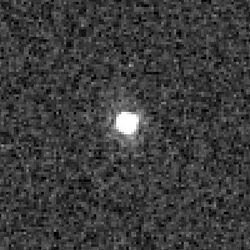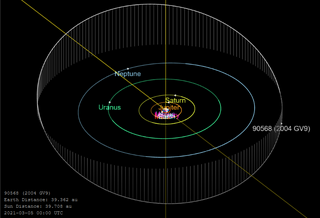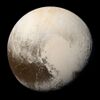Astronomy:(90568) 2004 GV9
 Hubble Space Telescope image of 2004 GV9, taken on March 2010 | |
| Discovery[1] | |
|---|---|
| Discovered by | NEAT |
| Discovery date | 13 April 2004 |
| Designations | |
| 2004 GV9 | |
| Minor planet category | Cubewano (MPC)[2] Extended (DES)[3] |
| Orbital characteristics[4] | |
| Epoch 13 January 2016 (JD 2457400.5) | |
| Uncertainty parameter 2 | |
| Observation arc | 22031 days (60.32 yr) |
| Earliest precovery date | 21 December 1954 |
| |{{{apsis}}}|helion}} | 45.618 astronomical unit|AU (6.8244 Tm) |
| |{{{apsis}}}|helion}} | 38.7281 AU (5.79364 Tm) |
| 42.173 AU (6.3090 Tm) | |
| Eccentricity | 0.081681 |
| Orbital period | 273.88 yr (100034 d) |
| Mean anomaly | 34.6030° |
| Mean motion | 0° 0m 12.956s / day |
| Inclination | 21.9718° |
| Longitude of ascending node | 250.6142° |
| 293.200° | |
| Earth MOID | 37.7917 AU (5.65356 Tm) |
| Jupiter MOID | 33.6786 AU (5.03825 Tm) |
| Physical characteristics | |
| Dimensions | 680±34 km[5] |
| Rotation period | 5.86 h (0.244 d) |
| Sidereal rotation period | 5.86 h[4] |
| Geometric albedo | 0.077+0.0084 −0.0077[5] |
| BR[5] B−V=0.95, V−R=0.52[6] B0−V0=0.843[7] | |
| Apparent magnitude | 19.9[8] |
| Absolute magnitude (H) | 4.25±0.04[5] 4.0[4] |
(90568) 2004 GV9 (provisional designation 2004 GV9) is a trans-Neptunian object that was discovered on April 13, 2004 by NEAT.[1] It has been listed as a cubewano by the Minor Planet Center.[2] It was discovered on 13 April 2004 by NEAT. It has been observed forty-seven times, with precovery images back to 1954.[4] The object has an orbital period of 273.88 years. Its maximum possible distance from the Sun (aphelion) is 45.62 AU, and its closest (perihelion) is 38.7 AU, and currently 39.7 AU from the sun. It has an inclination of 21.9718, and eccentricity of 0.082.
M. E. Brown estimates that is very likely a dwarf planet.[9] A diameter of 680±34 km has been determined from combined observations of the Herschel and Spitzer space telescopes.[5] Tancredi notes that light-curve-amplitude analysis shows only small deviations, suggesting that (90568) 2004 GV9 could be a spheroid with small albedo spots and hence a dwarf planet.[10] However, its low albedo suggests it has never been resurfaced and thus is unlikely to have planetary geology.
References
- ↑ 1.0 1.1 Spahr, Timothy B. (2004-04-14). "MPEC 2004-G32 : 2004 GV9". IAU Minor Planet Center. Harvard-Smithsonian Center for Astrophysics. http://www.cfa.harvard.edu/mpec/K04/K04G32.html. Retrieved 2010-01-06.
- ↑ 2.0 2.1 "MPEC 2009-R09 : Distant Minor Planets (2009 SEPT. 16.0 TT)". IAU Minor Planet Center. 2009-09-04. http://www.cfa.harvard.edu/mpec/K09/K09R09.html. Retrieved 2009-10-04.
- ↑ Marc W. Buie. "Orbit Fit and Astrometric record for 90568". SwRI (Space Science Department). http://www.boulder.swri.edu/~buie/kbo/astrom/90568.html. Retrieved 2009-10-04.
- ↑ 4.0 4.1 4.2 4.3 "JPL Small-Body Database Browser: 90568 (2004 GV9)". https://ssd.jpl.nasa.gov/sbdb.cgi?sstr=90568. Retrieved 7 April 2016.
- ↑ 5.0 5.1 5.2 5.3 5.4 Vilenius, E. et al. (2012). ""TNOs are Cool": A survey of the trans-Neptunian region VI. Herschel/PACS observations and thermal modeling of 19 classical Kuiper belt objects". Astronomy & Astrophysics 541: A94. doi:10.1051/0004-6361/201118743. Bibcode: 2012A&A...541A..94V.
- ↑ Tegler, Stephen C. (2007-02-01). "Kuiper Belt Object Magnitudes and Surface Colors". Archived from the original on 2006-09-01. https://web.archive.org/web/20060901063349/http://www.physics.nau.edu/~tegler/research/survey.htm. Retrieved 2009-12-30.
- ↑ David L. Rabinowitz; Bradley E. Schaefer; Martha W. Schaefer; Suzanne W. Tourtellotte (2008). "The Youthful Appearance of the 2003 EL61 Collisional Family". The Astronomical Journal 136 (4): 1502–1509. doi:10.1088/0004-6256/136/4/1502. Bibcode: 2008AJ....136.1502R.
- ↑ "AstDys (90568) 2004GV9 Ephemerides". Department of Mathematics, University of Pisa, Italy. https://newton.spacedys.com/astdys/index.php?pc=1.1.3.0&n=90568. Retrieved 2009-10-06.
- ↑ Michael E. Brown. "How many dwarf planets are there in the outer solar system? (updates daily)". California Institute of Technology. http://web.gps.caltech.edu/~mbrown/dps.html. Retrieved 30 August 2016.
- ↑ Tancredi, G., & Favre, S. (2008) Which are the dwarfs in the Solar System?. Depto. Astronomía, Fac. Ciencias, Montevideo, Uruguay; Observatorio Astronómico Los Molinos, MEC, Uruguay. Retrieved 10-08-2011
External links
 |




